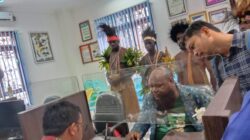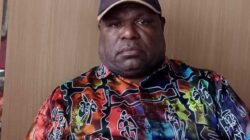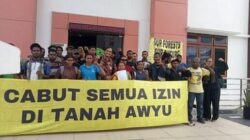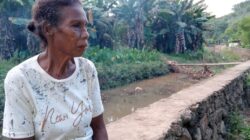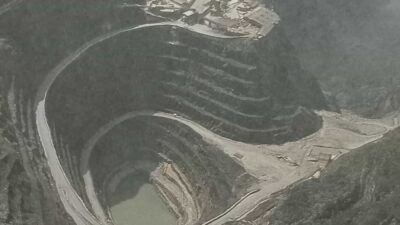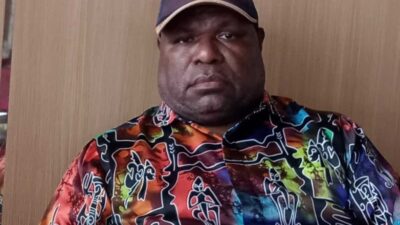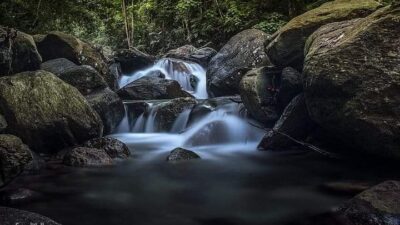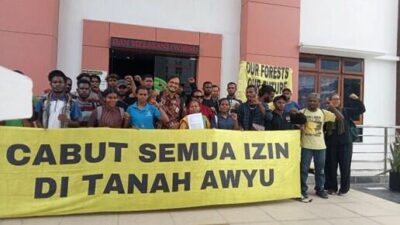Jayapura, Jubi – In 2001, Forest Watch Indonesia (FWI) and Global Forest Watch (GFW) jointly published a report titled “Portrait of Indonesia’s Forests,” which included maps and photos depicting the environmental facts and the state of tropical forests in Indonesia, particularly in Papua.
At that time, Indonesia had three islands known for their lush forests: Kalimantan, Sulawesi, and Irian Jaya, now Papua, encompassing seven provinces. Papua was considered an area of highly diverse endemic flora and fauna. An example of a Papua endemic plant is the Sowang wood, or Xanthosthemon novaguineense Valeton, found only in the Cycloop mountain range, situated between Jayapura City and Jayapura Regency. This plant possesses fire resistance but limited regeneration capabilities.
Besides timber, Papua is abundant in non-timber forest products such as rattan and traditional medicines. Papua boasts Indonesia’s largest mangrove forest, covering 1.63 million hectares, yet this ecosystem faces threats, notably in Youtefa Bay and coastal areas of Mimika, with 300,000 hectares of mangroves, some reaching heights of 30 meters, experiencing degradation.
To address these issues, Greenpeace, Pusaka, Walhi Papua, Jubi TV, and LBH Papua organized a public discussion titled “Save Papua’s Forests and Indigenous Peoples” at the Office of the Evangelical Christian Church Women’s Development and Training Center in Jayapura City on October 6, 2023.
Totok Dwi, an Environmental Law Lecturer at Gadjah Mada University, highlighted the prolonged exploitation of Papua’s forests, emphasizing that Papua is one of the last remaining forested areas. Forest exploitation has persisted since the New Order era, with numerous Forest Concession Rights (HPH) granted, and it has intensified during the reform era. He criticized the view that forests are merely commodities for profit.
Dwi discussed the evolving status of indigenous Papuans, who have transitioned from being landowners to visitors, denied direct access to their customary lands and forests. He stressed the importance of not only legal actions but also campaigns to secure indigenous rights over customary lands and forests, preserving the symbiotic relationship between nature and Papuan indigenous communities.
Emanuel Gobay, Director of LBH Papua and part of the Advocacy Team to Save Papua’s Indigenous Forests, pointed out that the continuous expansion of oil palm plantations by corporations threatens indigenous peoples’ customary lands and forests. He cited international and national legal foundations, including the UN Declaration on the Rights of Indigenous Peoples, the 1945 Constitution, Law No. 39 of 1999, and Law No. 2 of 2021, as supporting indigenous land ownership claims.
Gobay highlighted the impact of PT Indo Asiana Lestari (PT IAL) on the Woro clan’s land in Boven Digoel, where indigenous people lost 36,094 hectares of customary land. This encroachment not only endangers their living space but also the vital oxygen provided by the Awyu customary forest.
He mentioned Tom Beanal and Mama Yosepha Alomang’s legal actions against PT Freeport in the United States court as part of the struggle against corporations.
Elvira Rumkabu, an academic from the University of Cendrawasih (Uncen), discussed the adverse effects of corporate activities on local communities, including social conflicts, ecological changes, and the displacement of indigenous people.
She cited research presented in the book “Seizing Control of Life (The Struggle of the Wambin People in Boven Digoel Facing Investment Invasion)” co-authored by Rumkabu, Apriana Anastasia Amenes, Asrida Elisabeth, and I Ngurah Suryawan.
Rumkabu highlighted the formation of hamlet masters by corporations, resulting in internal conflicts. She emphasized the need for active resistance by indigenous communities, symbolized by the red cross. However, she stressed that symbolic actions alone are insufficient, and indigenous peoples must continue to fight for their customary territories.
The public discussion saw participation from students, activists, and NGOs in Jayapura City. In conclusion, the 2001 Portrait of Indonesia’s Forests report attributed deforestation in Indonesia to a corrupt political and economic system that prioritizes resource exploitation for personal gain.
The report warned that Indonesia’s lowland tropical forests, rich in timber and biodiversity, were at high risk of depletion. Additionally, almost half of Indonesia’s forest area, including Papua, had been fragmented by roads and development activities, prompting conservation efforts in the face of expansion and investment in the New Autonomous Region.



